In today’s competitive business landscape, ensuring quality in products and services is not just a priority but a necessity. Implementing an effective Quality Management System (QMS) can be a game-changer for your business, helping you maintain consistency, meet customer expectations, and comply with regulations.

Understanding Quality Management Systems
A Quality Management System is a structured framework that documents processes, procedures, and responsibilities for achieving quality policies and objectives. It helps organizations coordinate and direct their activities to meet customer and regulatory requirements and improve their efficiency and effectiveness on a continuous basis.
Key Components of a Quality Management System
- Quality Policy: This is a formal statement from management, closely linked to the business and marketing plan, about the quality of products and services.
- Quality Objectives: These are the goals that an organization strives to achieve, which should be measurable and aligned with the quality policy.
- Quality Manual: A document that provides an overview of the QMS, outlining the scope, processes, and procedures.
- Procedures and Instructions: These are detailed documents that explain how to perform tasks and processes.
- Records: Documentation that provides evidence of conformity and effectiveness of the QMS.
Steps to Implement a Quality Management System

Implementing a QMS requires careful planning and execution. Here are the steps to follow:
1. Define Your Quality Policy and Objectives
The first step in implementing a QMS is to establish a clear quality policy and set quality objectives. Your quality policy should reflect your organization’s commitment to meeting customer expectations and regulatory requirements. Quality objectives should be specific, measurable, achievable, relevant, and time-bound (SMART).
2. Identify and Document Processes
Next, identify the key processes that impact product and service quality. Document these processes in detail, including inputs, outputs, responsibilities, and performance indicators. This documentation will serve as a foundation for your QMS and help ensure consistency in your operations.
3. Develop a Process-Based Approach
A process-based approach focuses on understanding and managing interrelated processes to achieve desired outcomes. Identify the interactions between processes and ensure they are effectively managed to optimize performance.
4. Implement Risk-Based Thinking
Incorporate risk-based thinking into your QMS to proactively identify and address potential risks. Conduct risk assessments to evaluate the likelihood and impact of risks, and develop strategies to mitigate them. This approach helps prevent quality issues before they occur and enhances your organization’s ability to adapt to changes.
Quality Control Process

by Claudio Schwarz (https://unsplash.com/@purzlbaum)
Quality control is a critical component of any QMS. It involves monitoring and measuring processes and products to ensure they meet established quality standards. Here’s how to establish an effective quality control process:
1. Set Quality Standards
Define quality standards for your products and services based on customer requirements, industry regulations, and best practices. These standards will serve as benchmarks for evaluating performance.
2. Conduct Regular Inspections and Audits
Perform regular inspections and audits to assess compliance with quality standards. Use checklists and audit tools to systematically evaluate processes and identify areas for improvement.
3. Analyze Data and Identify Trends
Collect data on quality performance and analyze it to identify trends and patterns. Use statistical methods and software tools to gain insights into process performance and make data-driven decisions.
4. Implement Corrective and Preventive Actions
When quality issues are identified, take corrective actions to address the root cause and prevent recurrence. Implement preventive actions to mitigate potential risks and continuously improve your quality control process.
Performance Management System
A performance management system is essential for monitoring and evaluating the effectiveness of your QMS. It provides a framework for setting performance targets, measuring progress, and driving continuous improvement.
1. Define Key Performance Indicators (KPIs)
Identify key performance indicators (KPIs) that align with your quality objectives and provide insights into your QMS performance. Common KPIs include defect rates, customer satisfaction scores, and process efficiency metrics.
2. Monitor and Report Performance
Regularly monitor and report on QMS performance using dashboards and performance reports. Share this information with stakeholders to promote transparency and accountability.
3. Conduct Management Reviews
Hold regular management reviews to evaluate the effectiveness of your QMS and identify opportunities for improvement. Use these reviews to assess progress toward quality objectives, analyze performance data, and make informed decisions.
4. Foster a Culture of Continuous Improvement
Encourage a culture of continuous improvement by empowering employees to identify and implement process enhancements. Provide training and resources to support their efforts and recognize their contributions to quality improvement.
Benefits of Implementing a QMS
Implementing an effective QMS offers numerous benefits:
- Improved Customer Satisfaction: Consistently meeting customer expectations leads to higher satisfaction and loyalty.
- Enhanced Operational Efficiency: Streamlined processes and reduced waste result in cost savings and increased productivity.
- Regulatory Compliance: A QMS ensures compliance with industry standards and regulations, reducing the risk of fines and penalties.
- Increased Market Competitiveness: A reputation for quality can enhance your brand image and provide a competitive advantage.
- Facilitated Growth and Innovation: A strong QMS supports scalability and innovation by providing a solid foundation for expansion.
Conclusion
Implementing an effective Quality Management System is essential for organizations seeking to maintain high quality standards and achieve long-term success. By following the steps outlined in this article, you can establish a QMS that enhances your quality control processes and strengthens your performance management system. With a commitment to continuous improvement and a focus on customer satisfaction, your organization will be well-positioned to thrive in today’s competitive business landscape.